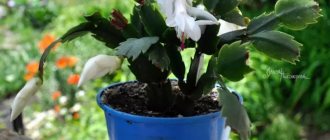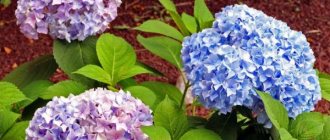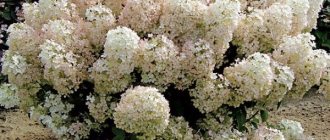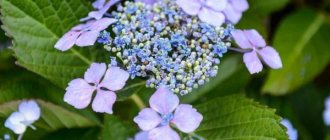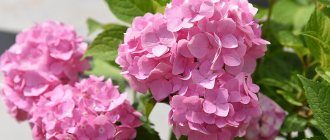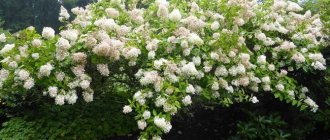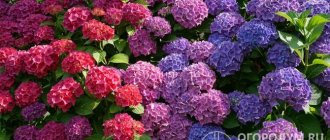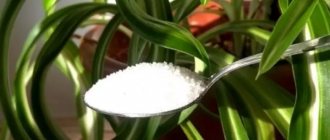Hydrangea can rightfully be called the queen of the garden. It blooms amazingly beautifully and is good both on the bush and as a cut flower. But in order for the bushes to look healthy and bloom profusely, they require regular care. One of the important stages of care is the application of fertilizers, which provide the hydrangea with nutrients. In addition to traditional organic fertilizers and complex mineral fertilizers, there are also folk recipes that have been tested in practice by experienced gardeners and are guaranteed to work. Feeding hydrangea with kefir? Easily. It is these unconventional feedings that we will talk about in this article.
It is important to know that any root feeding should be carried out after preliminary watering of the hydrangea; fertilizers should not be poured into dry soil. This rule applies not only to the fertilizers described in the article, but also to any other organic or mineral fertilizers applied in liquid form.
Feeding hydrangea with kefir and other fermented milk products
To prepare a solution for feeding hydrangea in autumn and spring, kefir, fermented baked milk, yogurt or whey are suitable. The bacteria contained in fermented milk products are beneficial not only to people, but also to plants, as they enrich them with important amino acids and improve immunity.
Dilute a liter of any fermented milk product in five liters of water, and then pour the hydrangea at the root. You can also carry out foliar feeding, but for this you need to prepare a less concentrated solution (0.5 liters of fermented milk product per 10 liters of water). Spray the hydrangea with the resulting solution.
Do I need to feed hydrangea after planting?
Fertilizers do not always have a positive effect, and often gardeners themselves make mistakes and apply them even when it is not necessary. This, for example, happens with young plantings of shrubs. They do not need feeding, and for these reasons:
- when planting, nutrients were already used (humus, humus, peat, potassium sulfate, urea and other components);
- young roots do not have time to absorb a large amount of nutrients;
- The plant is once again exposed to great stress.
The first feeding should be done when the bush is 3 years old or older. In some cases, exceptions can be made: it happens that in poor soil, hydrangea needs to be fed in the second and third year of life. Often, the plant itself signals the presence of problems and the need for additional nutrition: the leaves are poorly set, the green mass is growing slowly, and the shoots are drying out.
Attention! Before planting hydrangeas on the site, be sure to check the acidity of the soil. The pH should be between 5.5-6.0 units.
Potassium permanganate as a top dressing
It's no secret that potassium permanganate solution is used to disinfect soil and planting material. This solution effectively helps eliminate germs and pathogenic bacteria. In addition, the oxygen contained in this compound nourishes the root system, and potassium strengthens the branches of hydrangea and makes them less brittle and more flexible.
To carry out root feeding, you need to prepare a weak light pink solution; for each adult bush you will need a ten-liter bucket of such a solution. In the spring, when the plant comes out of dormancy, you can carry out foliar feeding and spray the hydrangea branches with this solution.
Timing for fertilizing
The spring period lasts a long time, so fertilizers are applied several times, alternating organic matter with minerals. There are several main stages:
- the first cycle begins in early spring, as soon as the snow has melted from the ground. The temperature should be 5-7 degrees Celsius. At this time, the hydrangea roots are already awakening from hibernation and entering the development phase. The main elements necessary for the development of culture are nitrogen compounds;
- the second period for fertilizing occurs from April to May at a temperature of 12-15 degrees. They use fertilizers with manganese, phosphorus and other minerals;
- the third stage occurs in mid-May and at its end. Add potassium, calcium, and organic matter.
When preparing and applying fertilizers, it is important to observe the proportions of dilution of substances, as well as the interval between procedures. After each feeding, the bush will need time (about 2-3 weeks) to absorb nutrients in the soil.
Feeding hydrangea with citric acid and vinegar
Hydrangea is one of the few plants that prefers soil with a high level of acidity; in such soil it feels most comfortable and blooms well. To increase the acidity of the soil, you can use food products such as citric acid or apple cider vinegar. Such fertilizing can be carried out throughout the season with an interval of 20-25 days.
To prepare a solution of apple cider vinegar, you will need to dilute 100 g of the product in a bucket of water. To prepare a solution of citric acid, first dissolve two tablespoons of the substance in 1 liter of water, and then increase the volume to 10 liters.
What to do before applying fertilizers
How to feed hydrangea in spring for lush flowering in the garden
You can’t just pour fertilizer on a plant. Hydrangea is pre-prepared:
- Before feeding, the flower must be watered with water. It is strictly not recommended to fertilize dry soil.
- A small and shallow trench is dug around the root system (at a distance of 10-15 cm). Mineral preparations are added to it.
- Work is carried out only in the morning or evening.
Note! It is advisable to water the hydrangea at least 1-2 days before applying fertilizer.
Rusks and yeast as top dressing
An unusual top dressing can also be prepared from dried bread. A third of a bucket of crackers and two thirds of crushed weeds should be filled with water, closed and left for seven days. During this period, the fertilizer should ferment. Then the infusion should be filtered (the grounds can be sent to the compost heap) and the resulting concentrate should be diluted with five parts of water. This fertilizer contains everything you need for the full growth and flowering of hydrangea.
Instead of bread crumbs, you can use fresh yeast; for this, dissolve one hundred grams of the product and a spoonful of sugar in ten liters of water and leave for 24 hours. During this time, the solution will begin to ferment, and it will be possible to water the hydrangeas with it. Each bush will require 5 liters of nutrient solution.
The need for spring feeding
In the spring, like most plants, hydrangea begins its growing season: at this time, young shoots are actively developing and there is an intensive accumulation of young green mass. If the bush does not have enough nutrition, this manifests itself in the following:
- shoots become thin;
- the leaves grow sparsely and have a faint color;
- the growth of the bush noticeably slows down.
The presence of these signs indicates the need for feeding, otherwise, if there is inaction on the part of the gardener, the plant will die altogether.
Applying fertilizers in the spring helps supply the hydrangea with the necessary substances, so during the summer it will develop intensively and bloom profusely. In addition to adding additives, the soil needs to be moistened, especially bushes aged 3 years and older. Mineral and organic fertilizers, as well as complex preparations, are used as spring fertilizing. Interesting!
The second name for hydrangea is hydrangea, or in other words: “loving water.”
How to feed hydrangea in spring
Awakening from winter sleep for a plant is due to the active growth of green mass. Nitrogen is responsible for the growth of foliage, shoot growth and bud formation. As part of the spring fertilizer for hydrangea, it plays a central role.
Spring feeding of the plant is carried out when the soil has dried and the hydrangea leaves have blossomed. Prepare a mixture of:
- urea,
- potassium sulfate.
A matchbox of each type of fertilizer is filled with a bucket of water. For each adult bush, use half a bucket, watering the bush at the root.
Important! Root feeding of plants is carried out only on moist soil! Otherwise, you can burn the roots.
In early spring, hydrangea can be fed:
- mullein infusion (1 part manure to 10 parts water),
- chicken droppings (1 part fertilizer and 14 parts water).
The solution is prepared by pouring manure or droppings with water. The mixture is infused for a day. The consumption rate is 5 liters per adult plant, 1-2 liters are enough for young seedlings.
Tree hydrangea and grandiflora hydrangea respond especially well to this feeding.
Experienced gardeners often use Pokon fertilizer for rhododendrons and azaleas. Nitrogen and potassium occupy the main part of the fertilizing composition. This is a long-lasting fertilizer that can be simply scattered under the bushes in the spring; its effect on the plant will not weaken until autumn.
The current fertilizer for spring feeding of hydrangea is the Russian fertilizer “Flower Paradise”. In addition to accelerating the growth of foliage and increasing the number of buds, the drug strengthens the plant’s immunity and protects it from the negative effects of frost.
During budding, compositions containing potassium and phosphorus are prepared for hydrangea. This can be superphosphate, in an amount of 20 g per 10 liters of water; or ready-made mineral fertilizer with a predominance of the necessary substances (Agricola, Kristalon).
To give flexibility to the shoots of ornamental shrubs, the plant is sprayed with a pink solution of potassium permanganate three times in the spring. Treatment with potassium permanganate will protect hydrangea from a number of fungal diseases.
If the leaves turn yellow
Hydrangea often emerges from winter sleep weakened, its leaves grow poorly, their leaves turn yellow and become smaller. The most common cause of this plant condition is a lack of nitrogen. An “ambulance” for the bush will be spraying the hydrangea crown with ammonia. Ammonia is an ammonia solution, that is, a nitrogen fertilizer. 2 tablespoons of ammonia are added to a bucket of clean water and the bush is sprayed from top to bottom. 1 – 2 treatments of the plant are enough.
Another reason for yellowing of hydrangea leaves may be a disease called chlorosis. The plant is treated by treating the leaves with iron sulfate and iron sulfate - 5 g of powder per 1 liter of water.
Bread crusts
Fertilizing based on bread crusts helps the bush to actively bloom.
Place the crusts in warm water and leave to ferment to form a sourdough starter. The water should completely cover the pieces. Next, you should cover the contents with a lid or a large plate, place some kind of press on it and leave for several days in a warm place. Rye or white bread is suitable for preparing top dressing.
Feeding hydrangea (Photo used under standard license ©azbukaogorodnika.ru)
You can also add egg shells or ash to the diluted bread sourdough. These substances contain calcium necessary for the soil. Since plants actively consume this macronutrient.
The finished starter needs to be diluted with water (1 part starter to 2 parts water) and you can start feeding. Hydrangea should be watered at the root.
The bush should be fertilized in the spring, when planting sprouts in the ground and during the formation of buds.
Bread crusts contain yeast, the nutrients in them nourish plants, improve soil quality, and help various organic substances work actively.
Fertilizing on bread crusts helps the roots develop well, accelerates the growth of the bush and allows you to achieve luxurious flowering of hydrangea.
Features of nitrogen nutrition of hydrangea
In moist soil, nitrogen in nitrate form is not only actively consumed by the plant, but is also quickly washed away with watering and natural precipitation. And nitrogen in ammonia form will take some time to convert into a consumable form. That is why ammonium nitrate is the most successful long-acting fertilizer.
In the nutritional system that we propose below, ammonium nitrate is used as a source of nitrogen, the main building element of cells, because it contains nitrogen in two forms: ammonium and nitrate.
Urea is often used as a fertilizer for hydrangeas, but in the case of hydrangeas it is not at all suitable for root feeding. In it, nitrogen has an amide form and to go through all the stages of conversion to nitrate, it will take three or four days, and during this time it will most likely simply be washed out without ever reaching the plant.
But you can use urea for foliar feeding. When sprayed with this solution, the hydrangea will be able to obtain 100% nitrogen. When processing, be sure to pay attention to the back side of the leaf, because this is where the stomata are located, through which the plant will absorb fertilizer.
Gardening tips
Hydrangea is moisture-loving. An adult plant is watered once a week, spending at least 25 liters of water for each bush.
Shrubs are often attacked by aphids. You can get rid of the pest by spraying the bushes with soapy water or garlic infusion (200 g of chopped cloves per bucket of water). If the bushes are severely damaged, use an insecticide solution.
After flowering, all faded inflorescences are cut off from the bush so that the plant does not weaken.
Elena Chursinova A practical gardener with twenty years of experience. I prefer organic farming and lazy gardening. ...
Fertilizing indoor hydrangea
Many beginners are interested in how to feed hydrangea growing in a pot at home. This plant spends the winter in a dormant period, but from mid-spring until late autumn it pleases with its abundant flowering. Flower care begins in mid-February, when the pot is exposed to light and the soil is watered. For feeding, use complex fertilizer for hydrangeas and flowering plants - azaleas, rhododendron. To speed up flowering during budding, spray the indoor plant with gibberellin (0.1 g per 1 liter of water).
Indoor varieties are fed once every two weeks until early autumn. Make sure that the mixtures do not contain alkali, which has a detrimental effect on hydrangea. Follow the instructions on the package to avoid excess fertilizer. Only with proper care do large inflorescences form on the tops of the dark green stems, delighting with their bright colors for several months.
What are the results after watering?
Watering with fermented milk solution is carried out in the summer, no more than once every 20 days. You need to stop fertilizing the bush with this mixture in mid-August. This method of feeding is quite simple, but effective.
Use of this product:
- increases the splendor of inflorescences;
- prolongs flowering time;
- is a prevention against various diseases.
You might be interested in learning how to acidify soil for hydrangeas.
Fermented milk fertilization is one of the traditional methods of fertilization, but the benefits from it are enormous, as are the benefits from specialized preparations.
Kefir
It is known that hydrangea loves acidified soil, therefore, when caring for it, it is necessary to ensure the introduction of acidic components, one of which is kefir. It is worth understanding that this fermented milk product contains amino acids and minerals necessary for the normal development of garden plants.
It’s good to wash often: myths about shampoo and hair care that only harm
“We are still friends”: Derevianko commented on the breakup with his wife
A student at the Vietnam Police Academy shared how she takes care of her facial skin.
To prepare a good fertilizer, you should dilute kefir with water in a ratio of 1:10. After this, the product should be thoroughly mixed and applied under the bush. To get the best effect from watering with this fertilizer, you need to pour out a whole bucket of liquid (10-11 liters) at a time.
The advantage of this kefir fertilizer is that it contains lactic acid bacteria, which are not capable of causing damage to the plant and at the same time prevent the development of fungal diseases.
Consequences of deficiency and excess of fertilizers
If uncharacteristic external changes appear on the plant, this is the first sign of improper application or lack of nutrients. For example, with a lack of potassium, brown spots appear on the flower.
Timely plant care
An overabundance of micronutrients is difficult to correct:
- If the soil is oversaturated with nitrogen, the plant will not be able to survive the winter season. The buds and young stems will freeze. An excess of nitrogen usually leads to the fact that hydrangea may not bloom at all.
- If you do not combine fertilizing with watering, too much salt concentration will accumulate in the soil. The root system will stop forming.
- An excess of potassium will lead to a sharp yellowing of the foliage, and the inflorescences will begin to fade.
On a note ! It is prohibited to use nitrogen fertilizers before hibernation.
Pre-watering will balance the level of microelements in the soil. The application of any organic or mineral products should be carried out only when absolutely necessary.
Wonderful garden decoration
Proper and timely fertilization of the soil will not only help you grow a beautiful bush, but will also give you long-lasting flowering. With the help of fertilizing, you can develop the immunity necessary for the winter period.
